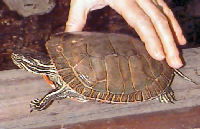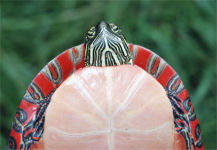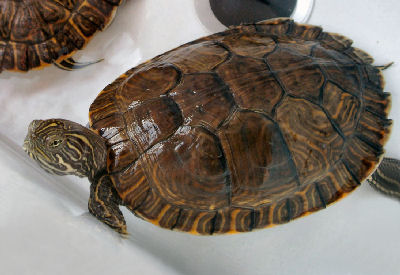Painted Turtles can can handle a wide variety of conditions and will become quite tame, making them wonderful pets!
There are four species of Painted Turtles and all of them are great for a turtle enthusiast. They are baskers and are very alert, plopping into the water at the approach of their keeper. However they will soon become tame, and though they dive off into the water of the enclosure, they will quickly surface to see if any food has been offered.
 Painted Turtle Chrysemys picta Photo © Animal-World |
Painted Turtles have fairly modest requirements and can be quite hardy when provided with the right environment. Turtles don’t instill the cautious concerns that some folks have when dealing with other types of reptiles. But Painted Turtles do get larger than most first-time pet buyers realize. Adults will reaching 10 -11″ inches within five or six years.
Painted turtles are similar in appearance and behavior to the sliders and cooters. Though Southern Painted Turtles are less cold tolerant, as a group painted turtles make wonderful pets. They are hardy, become quite tame in captivity, and live a long time.
For more Information see:
Selecting and Caring for Your Turtle or Tortoise
- Kingdom: Animalia
- Phylum: Chordata
- Class: Reptilia
- Order: Testudines
- Family: Emydidae
- Genus: Chrysemys
- Species: picta
Distribution:
Painted turtles are widespread throughout the United States from Canada to Mexico.
Status
These turtles are not listed on the IUCN Red List.
Description:
Painted turtles are some of the most beautiful turtles in the world and definitely in the United States. Depending on the subspecies, they have medium to dark green carapaces with amazingly fascinating peach to bright red plastrons with complex squiggles, swirls, and designs in black and pale yellow. Adult female painted turtles grow to 11″ to 12″ (13 to 15 cm) with adult males considerably smaller, usually 5″ to 6″.
There are four subspecies of Painted Turtles:
|
- Western Painted Turtle C. p. bellii was described by Gray in 1831. They are found from Canada and the northwestern United States south to Wisconsin, Kansas, Missouri, New Mexico, and Arizona. This species is the largest painted turtle, reaching 7″ to 8″ as adults.
They have a beautiful green carapace covered with yellow to yellow-orange reticulations and a striking reddish plastron. They lay 10 to 12 eggs in the late spring or early summer and in the colder portions of its range, the babies overwinter inside the nest, emerging with the appearance of heat and rain in the spring. - Eastern Painted Turtle C. p. picta was described by Schneider in 1783. This species is very similar to the Midland Painted Turtle in both size and appearance though its range is essentially east of the Midland’s range. They are found from Nova Scotia, Canada south through New England down to Georgia and eastern Alabama.They can be found in brackish waters along the coast.
Just slightly larger than the Midland Painted Turtle, the Eastern Painted Turtle reaches only 6″. A unique trait of this turtle is that its has light bordered scutes arranged in basically a straight row, while the other Painted Turtles have scutes that alternate. Its plastron is solid colored and unmarked.
The Eastern Painted Turtle is very cold tolerant, and has been observed being active under ice (Pritchard, 1979). As with the other painted turtles, this turtle moves from a carnivorous lifestyle as a young turtle to an omnivorous adult. - Midland Painted Turtle C. p. marginata was described by Agassiz in 1857. This species is just slightly smaller than the Eastern Painted Turtle, reaching about 5.75 ” (14.6 cm). They are found from the Great Lakes of Canada south to Illinois, Tennessee, and Alabama. Females lay 3 to 7 eggs in the spring or early summer.
They have dark edges around their scutes, which are laid out in an alternating pattern, and the plastron develops a solid lengthwise dark blotch.
Midland Painted Turtle
Chrysemys picta marginata
Photo © Animal-World: Courtesy Russ Gurley - Southern Painted Turtle C. p. dorsalis was also described by Agassiz in 1857. This species is the smallest and probably the most attractive of the painted turtles. It is found in Illinois, Alabama, and along the Mississippi River to the Gulf of Mexico.
It grows to about 4″ to 5″ (10.2 – 12.7 cm) and has a dark green carapace with an orange stripe down the midline. It also has beautiful markings along the marginals and a complex red, yellow, and black plastron pronouncing these wonderful turtles as truly being the “painted turtle”.
Care and Feeding:
Young Painted Turtles are carnivorous, eagerly consuming fish, worms, crickets, and floating turtle food. As they grow they become more herbivorous. Adults enjoy water lettuce, water hyacinth, and duckweed in addition to romaine lettuce, kale, and other greens.
In captivity most will also eat commercial turtle food and will eat large amounts of the aquatic plants found in their enclosures.They need a healthy and varied foods as they are prone to nutritional problems and shell defects when fed insufficient diets.
Environment:
Indoors:
A basic setup with a large tub will be sufficient to hold three or four adult painted turtles. Add an efficient filtration system, a shop light fixture with UVB-emitting bulbs, and a basking spot with a 100-watt spotlight mounted above.
For these sun-loving and warmth-loving turtles, you can add a 250-watt submersible heater to raise the water temperature a few extra degrees and maintain the water at 78{deg} to 82{deg} F (26{deg} to 28{deg} C).
| A good beginning home for a small or baby Painted Turtle is an aquarium. Purchase at least a 20-gallon aquarium. Also required are a filter, a heater, a pump and airstone, a sandy or gravel substrate, live aquatic plants, chlorine remover and other water conditioners, and a small bulb to provide a basking spot for the young turtle. None of these supplies can be left out of the proper baby turtle enclosure. Fortunately, these turtles are typically very hardy captives and thrive in proper conditions. |
Outdoors:
The Painted Turtles do very well in outdoor ponds. In all but the coldest environments they are alert and active year-round. They are sun worshippers, so add plenty of branches and rock piles for them to climb out and bask. Also a lot of aquatic vegetation will keep these turtles happy.
The northern specimens will hibernate, so care must be taken that they have a planned terrestrial hibernation site with piles of leaves, mulch, and hay. Southern Painted Turtles are less cold tolerant and will need to be taken inside during the winter. They may become so slow-moving that they drown if they are caught outside and get too cold in deeper water.
Care must be taken that these, and any turtles, are not released into a wild habitat. The reasons are many. The introduction of non-native species can lead to the introduction of diseases and can lead to hybridization of introduced and native species. In addition, many turtles raised in captivity and released into wild situations are confused, unable to cope with extreme weather changes, and many surely fall prey quite quickly to the wary predators they may encounter.
Handling:
Captive-hatched specimens, as always, are the best to keep as pets and most will become so docile that they can easily be fed by hand. These and all aquatic turtles should be considered wonderful display animals and not pets that are easily held.
Breeding:
The captive breeding of Painted Turtles is simple and straightforward. Adults breed throughout the spring and a female can lay up to three clutches of 6-10 eggs each year. This species exhibits temperature dependent sex determination – eggs incubated at less than 81{deg} F (27{deg} C) produce males, 82{deg} to 86{deg} F (28{deg} to 30{deg} C) produce a mixed ratio, and above 86{deg} F (30{deg} C) produce females.
Hatchlings thrive in a warm environment with clean, filtered water and live plants, both floating and submerged. They will feed on a wide variety of insects, insect larvae, and small fish in addition to commercial turtle food.
Ailments / Health Problems:
Not many, but shell and skin infections will arise in specimens kept in stagnant or dirty water. These and all turtles should be fed a varied diet consisting of thawed fish, worms, insects, plants, and commercial diets. Feeding only commercial turtle pellets will lead to obesity, fixation on a single food source, and even kidney stones, fatty livers, and other medical conditions leading to death. Ear abscesses occur from poor water quality and specimens kept in too cold conditions.
Availability:
Painted Turtles are readily available from better pet stores, breeders at the larger reptile shows across the country, and on-line. A new keeper should try to find specimens that are captive-hatched and at least six to eight months old to ensure the turtle has been feeding well and is well on its way with a strong start. They are usually inexpensive to purchase but one must realize that the expenses of setting up a proper environment are considerable.

